Comprehensive Risk Management in Construction Project Planning
VerifiedAdded on 2023/06/11
|9
|2012
|257
Report
AI Summary
This report provides a comprehensive analysis of risk management within construction projects, focusing on the various phases of the project life cycle and associated risks. It begins by outlining the five phases of a construction project: conception and introduction, planning, execution, control, and closure, detailing the activities and critical considerations for each phase. The report identifies potential risks in each phase, including socio-political, design-related, safety, and execution risks, emphasizing the importance of early risk identification and mitigation. It discusses methods for risk analysis, such as brainstorming sessions and prioritization based on impact and probability. The report also explores the use of a risk matrix to prioritize risks and develop strategic plans for control and mitigation, including contingency plans. The strategies cover various aspects, from ensuring compliance with regulations and addressing social impacts to expert design reviews and resource management during execution. The report concludes by highlighting the necessity of proactive risk management to ensure project success and maintain organizational market value.
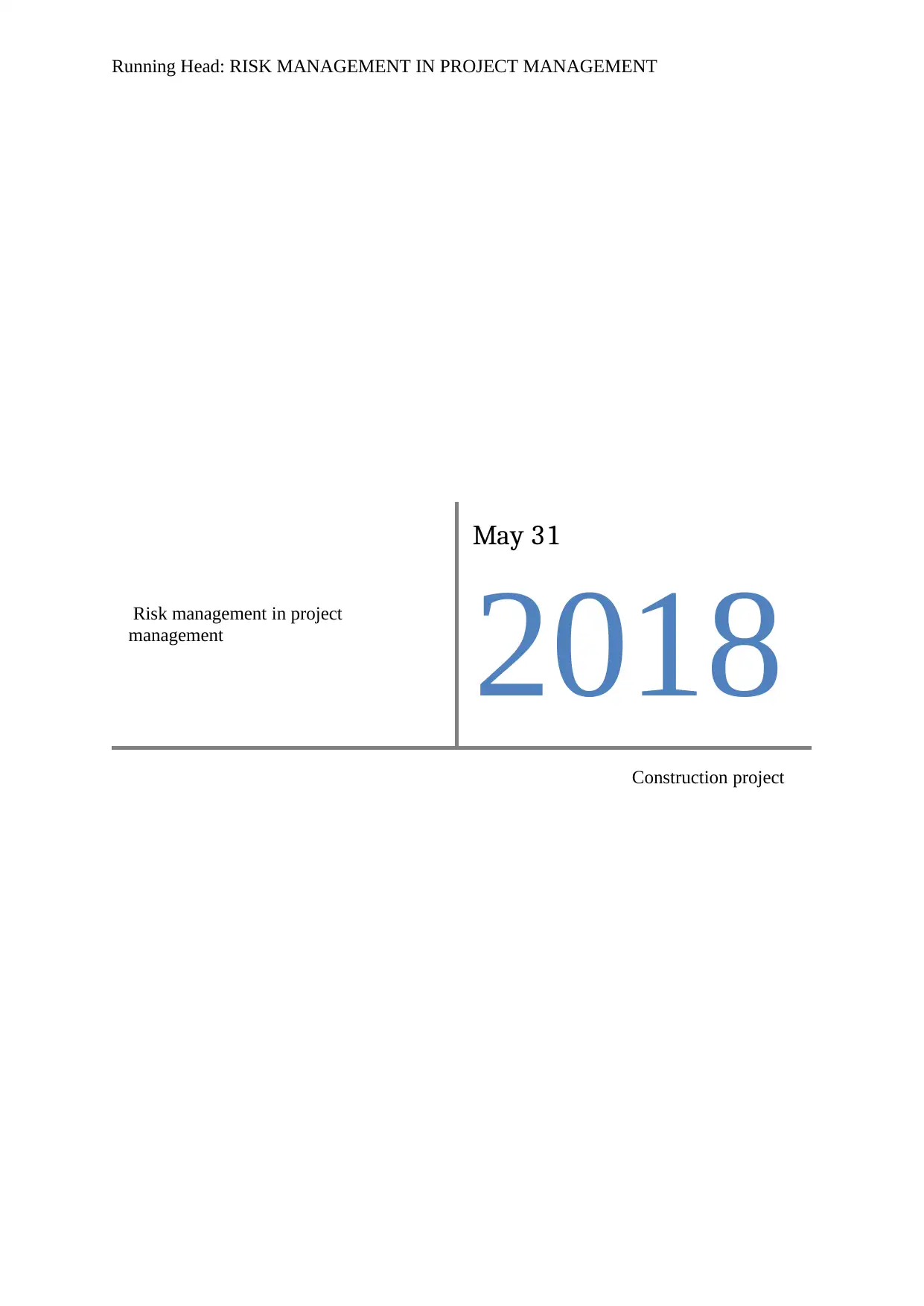
Running Head: RISK MANAGEMENT IN PROJECT MANAGEMENT
Risk management in project
management
May 31
2018
Construction project
Risk management in project
management
May 31
2018
Construction project
Paraphrase This Document
Need a fresh take? Get an instant paraphrase of this document with our AI Paraphraser
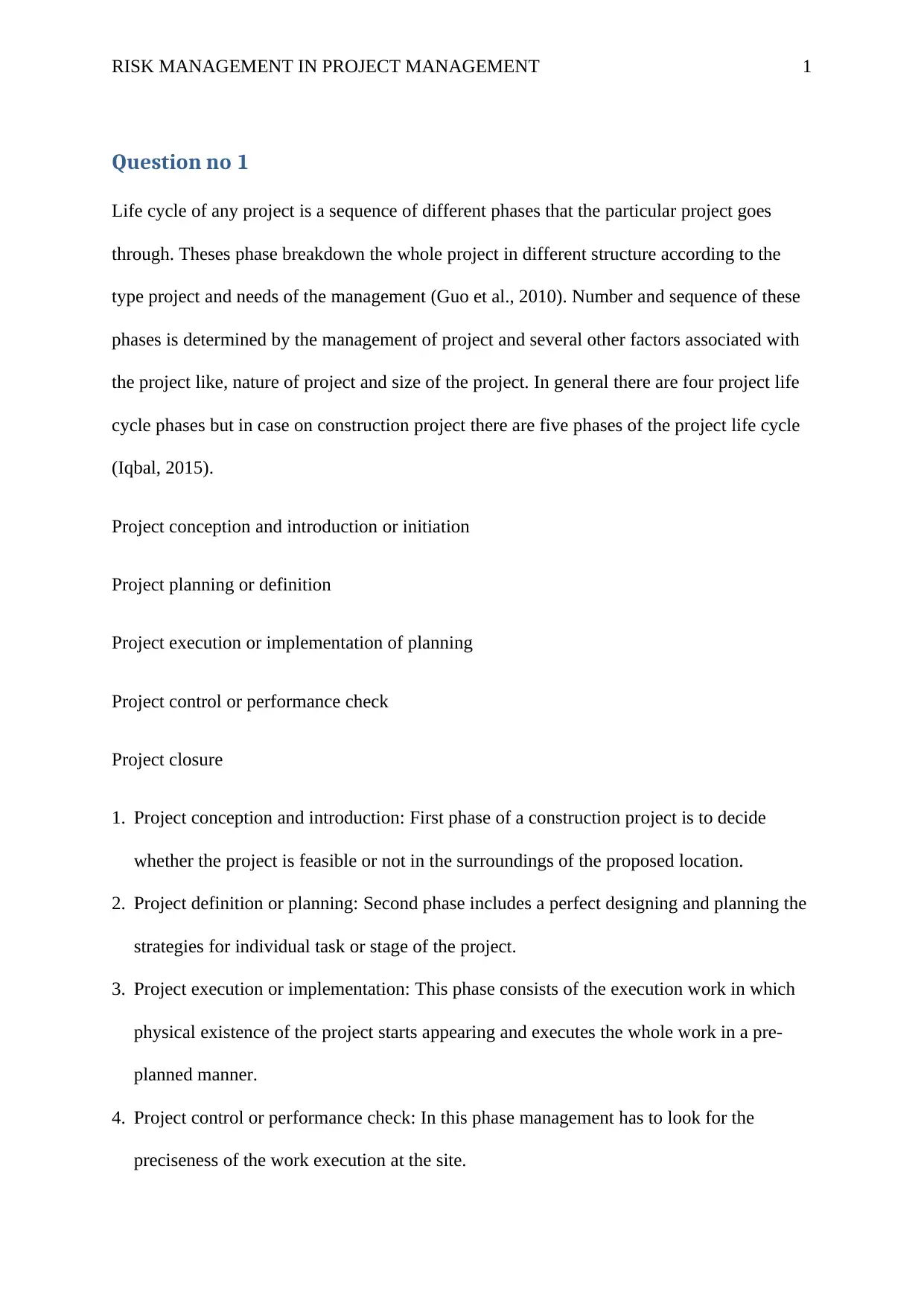
RISK MANAGEMENT IN PROJECT MANAGEMENT 1
Question no 1
Life cycle of any project is a sequence of different phases that the particular project goes
through. Theses phase breakdown the whole project in different structure according to the
type project and needs of the management (Guo et al., 2010). Number and sequence of these
phases is determined by the management of project and several other factors associated with
the project like, nature of project and size of the project. In general there are four project life
cycle phases but in case on construction project there are five phases of the project life cycle
(Iqbal, 2015).
Project conception and introduction or initiation
Project planning or definition
Project execution or implementation of planning
Project control or performance check
Project closure
1. Project conception and introduction: First phase of a construction project is to decide
whether the project is feasible or not in the surroundings of the proposed location.
2. Project definition or planning: Second phase includes a perfect designing and planning the
strategies for individual task or stage of the project.
3. Project execution or implementation: This phase consists of the execution work in which
physical existence of the project starts appearing and executes the whole work in a pre-
planned manner.
4. Project control or performance check: In this phase management has to look for the
preciseness of the work execution at the site.
Question no 1
Life cycle of any project is a sequence of different phases that the particular project goes
through. Theses phase breakdown the whole project in different structure according to the
type project and needs of the management (Guo et al., 2010). Number and sequence of these
phases is determined by the management of project and several other factors associated with
the project like, nature of project and size of the project. In general there are four project life
cycle phases but in case on construction project there are five phases of the project life cycle
(Iqbal, 2015).
Project conception and introduction or initiation
Project planning or definition
Project execution or implementation of planning
Project control or performance check
Project closure
1. Project conception and introduction: First phase of a construction project is to decide
whether the project is feasible or not in the surroundings of the proposed location.
2. Project definition or planning: Second phase includes a perfect designing and planning the
strategies for individual task or stage of the project.
3. Project execution or implementation: This phase consists of the execution work in which
physical existence of the project starts appearing and executes the whole work in a pre-
planned manner.
4. Project control or performance check: In this phase management has to look for the
preciseness of the work execution at the site.
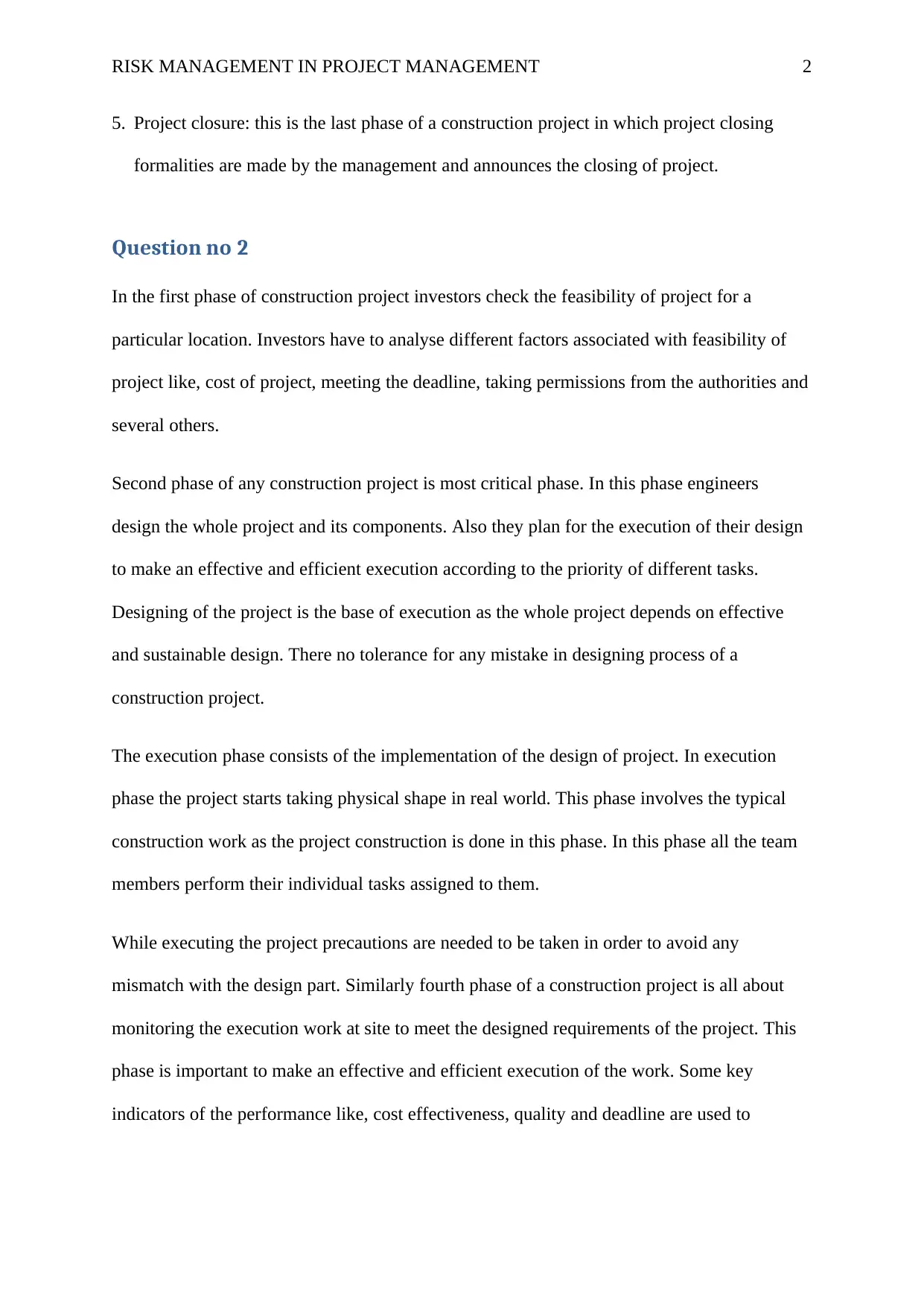
RISK MANAGEMENT IN PROJECT MANAGEMENT 2
5. Project closure: this is the last phase of a construction project in which project closing
formalities are made by the management and announces the closing of project.
Question no 2
In the first phase of construction project investors check the feasibility of project for a
particular location. Investors have to analyse different factors associated with feasibility of
project like, cost of project, meeting the deadline, taking permissions from the authorities and
several others.
Second phase of any construction project is most critical phase. In this phase engineers
design the whole project and its components. Also they plan for the execution of their design
to make an effective and efficient execution according to the priority of different tasks.
Designing of the project is the base of execution as the whole project depends on effective
and sustainable design. There no tolerance for any mistake in designing process of a
construction project.
The execution phase consists of the implementation of the design of project. In execution
phase the project starts taking physical shape in real world. This phase involves the typical
construction work as the project construction is done in this phase. In this phase all the team
members perform their individual tasks assigned to them.
While executing the project precautions are needed to be taken in order to avoid any
mismatch with the design part. Similarly fourth phase of a construction project is all about
monitoring the execution work at site to meet the designed requirements of the project. This
phase is important to make an effective and efficient execution of the work. Some key
indicators of the performance like, cost effectiveness, quality and deadline are used to
5. Project closure: this is the last phase of a construction project in which project closing
formalities are made by the management and announces the closing of project.
Question no 2
In the first phase of construction project investors check the feasibility of project for a
particular location. Investors have to analyse different factors associated with feasibility of
project like, cost of project, meeting the deadline, taking permissions from the authorities and
several others.
Second phase of any construction project is most critical phase. In this phase engineers
design the whole project and its components. Also they plan for the execution of their design
to make an effective and efficient execution according to the priority of different tasks.
Designing of the project is the base of execution as the whole project depends on effective
and sustainable design. There no tolerance for any mistake in designing process of a
construction project.
The execution phase consists of the implementation of the design of project. In execution
phase the project starts taking physical shape in real world. This phase involves the typical
construction work as the project construction is done in this phase. In this phase all the team
members perform their individual tasks assigned to them.
While executing the project precautions are needed to be taken in order to avoid any
mismatch with the design part. Similarly fourth phase of a construction project is all about
monitoring the execution work at site to meet the designed requirements of the project. This
phase is important to make an effective and efficient execution of the work. Some key
indicators of the performance like, cost effectiveness, quality and deadline are used to
⊘ This is a preview!⊘
Do you want full access?
Subscribe today to unlock all pages.

Trusted by 1+ million students worldwide
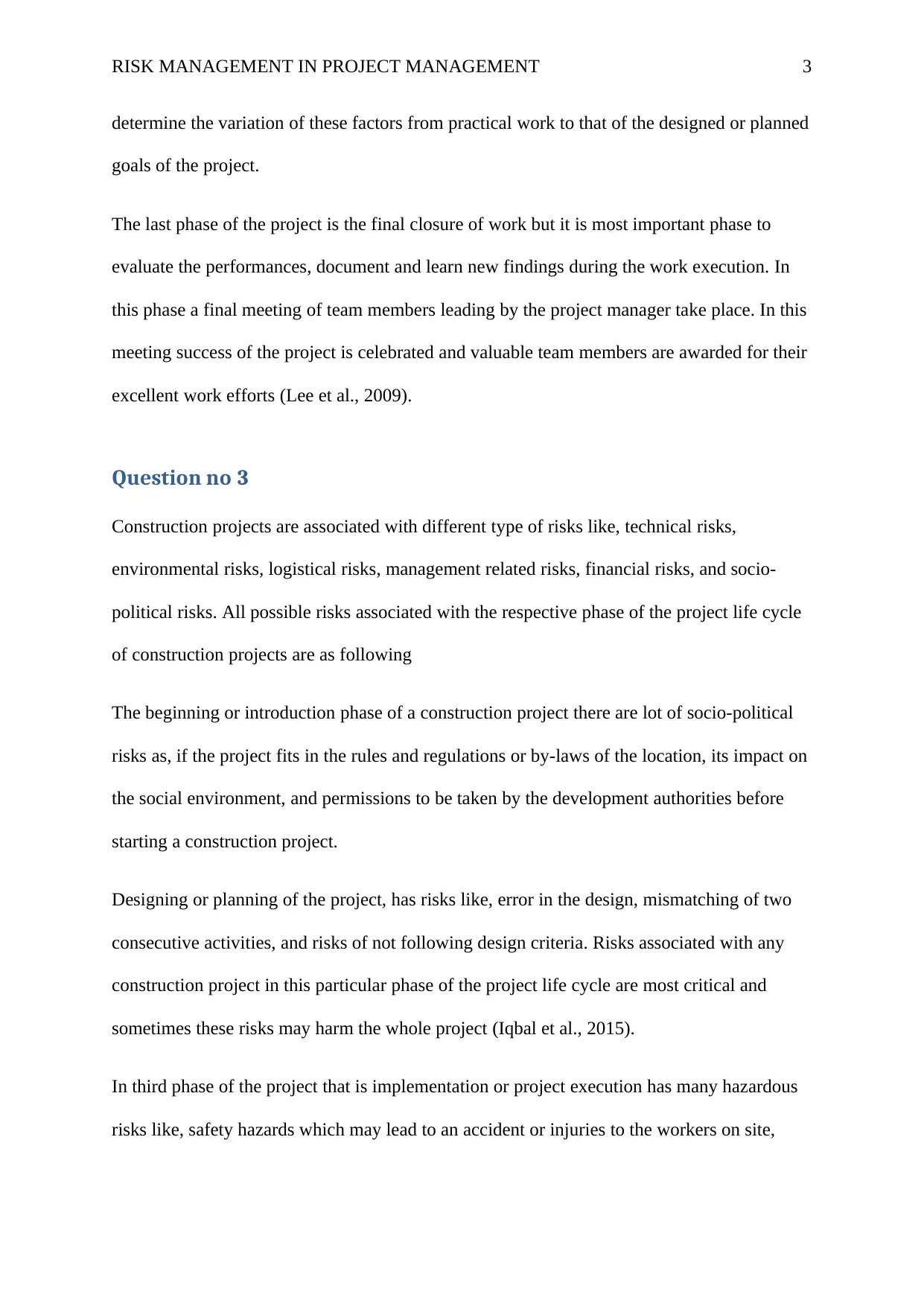
RISK MANAGEMENT IN PROJECT MANAGEMENT 3
determine the variation of these factors from practical work to that of the designed or planned
goals of the project.
The last phase of the project is the final closure of work but it is most important phase to
evaluate the performances, document and learn new findings during the work execution. In
this phase a final meeting of team members leading by the project manager take place. In this
meeting success of the project is celebrated and valuable team members are awarded for their
excellent work efforts (Lee et al., 2009).
Question no 3
Construction projects are associated with different type of risks like, technical risks,
environmental risks, logistical risks, management related risks, financial risks, and socio-
political risks. All possible risks associated with the respective phase of the project life cycle
of construction projects are as following
The beginning or introduction phase of a construction project there are lot of socio-political
risks as, if the project fits in the rules and regulations or by-laws of the location, its impact on
the social environment, and permissions to be taken by the development authorities before
starting a construction project.
Designing or planning of the project, has risks like, error in the design, mismatching of two
consecutive activities, and risks of not following design criteria. Risks associated with any
construction project in this particular phase of the project life cycle are most critical and
sometimes these risks may harm the whole project (Iqbal et al., 2015).
In third phase of the project that is implementation or project execution has many hazardous
risks like, safety hazards which may lead to an accident or injuries to the workers on site,
determine the variation of these factors from practical work to that of the designed or planned
goals of the project.
The last phase of the project is the final closure of work but it is most important phase to
evaluate the performances, document and learn new findings during the work execution. In
this phase a final meeting of team members leading by the project manager take place. In this
meeting success of the project is celebrated and valuable team members are awarded for their
excellent work efforts (Lee et al., 2009).
Question no 3
Construction projects are associated with different type of risks like, technical risks,
environmental risks, logistical risks, management related risks, financial risks, and socio-
political risks. All possible risks associated with the respective phase of the project life cycle
of construction projects are as following
The beginning or introduction phase of a construction project there are lot of socio-political
risks as, if the project fits in the rules and regulations or by-laws of the location, its impact on
the social environment, and permissions to be taken by the development authorities before
starting a construction project.
Designing or planning of the project, has risks like, error in the design, mismatching of two
consecutive activities, and risks of not following design criteria. Risks associated with any
construction project in this particular phase of the project life cycle are most critical and
sometimes these risks may harm the whole project (Iqbal et al., 2015).
In third phase of the project that is implementation or project execution has many hazardous
risks like, safety hazards which may lead to an accident or injuries to the workers on site,
Paraphrase This Document
Need a fresh take? Get an instant paraphrase of this document with our AI Paraphraser
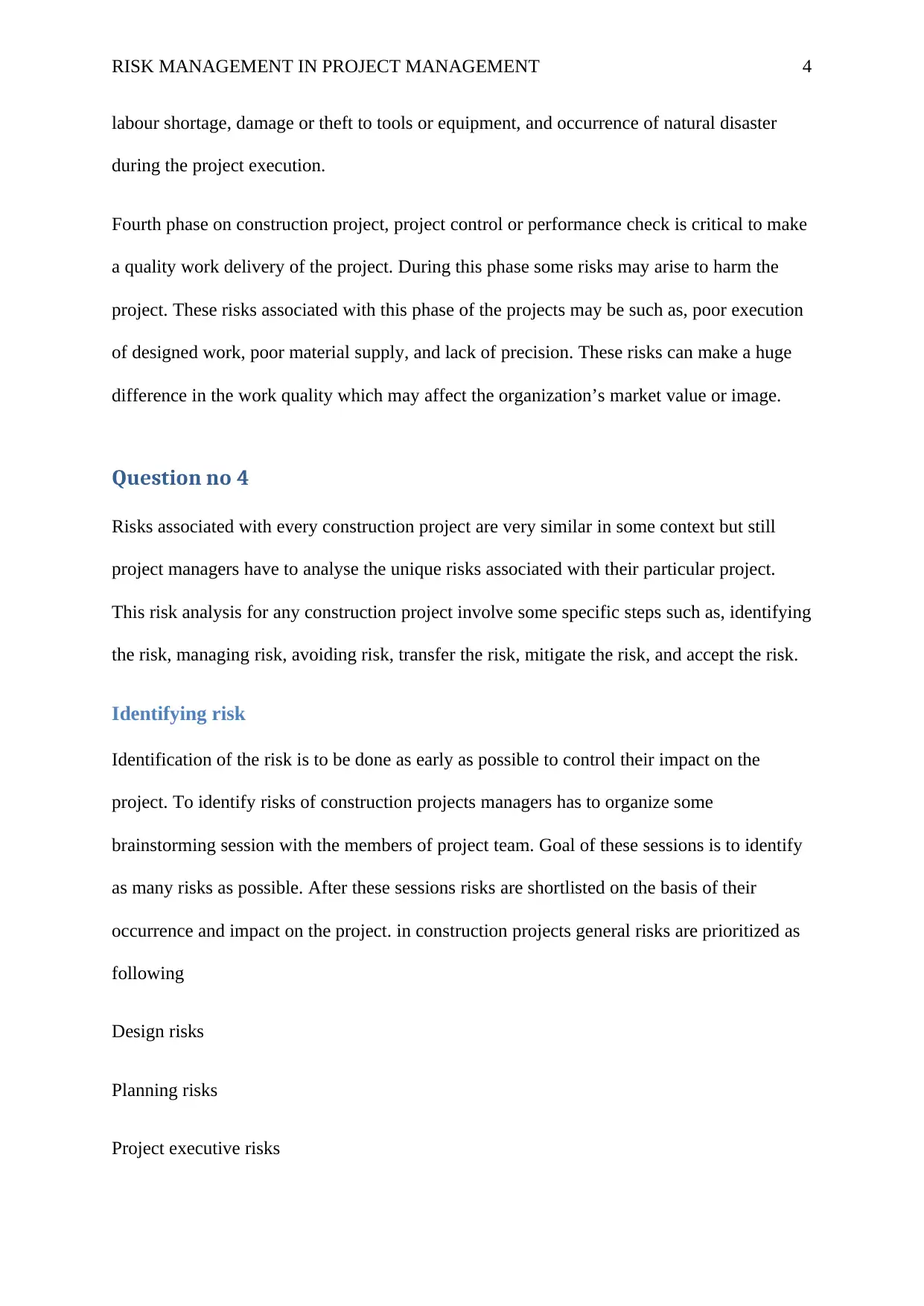
RISK MANAGEMENT IN PROJECT MANAGEMENT 4
labour shortage, damage or theft to tools or equipment, and occurrence of natural disaster
during the project execution.
Fourth phase on construction project, project control or performance check is critical to make
a quality work delivery of the project. During this phase some risks may arise to harm the
project. These risks associated with this phase of the projects may be such as, poor execution
of designed work, poor material supply, and lack of precision. These risks can make a huge
difference in the work quality which may affect the organization’s market value or image.
Question no 4
Risks associated with every construction project are very similar in some context but still
project managers have to analyse the unique risks associated with their particular project.
This risk analysis for any construction project involve some specific steps such as, identifying
the risk, managing risk, avoiding risk, transfer the risk, mitigate the risk, and accept the risk.
Identifying risk
Identification of the risk is to be done as early as possible to control their impact on the
project. To identify risks of construction projects managers has to organize some
brainstorming session with the members of project team. Goal of these sessions is to identify
as many risks as possible. After these sessions risks are shortlisted on the basis of their
occurrence and impact on the project. in construction projects general risks are prioritized as
following
Design risks
Planning risks
Project executive risks
labour shortage, damage or theft to tools or equipment, and occurrence of natural disaster
during the project execution.
Fourth phase on construction project, project control or performance check is critical to make
a quality work delivery of the project. During this phase some risks may arise to harm the
project. These risks associated with this phase of the projects may be such as, poor execution
of designed work, poor material supply, and lack of precision. These risks can make a huge
difference in the work quality which may affect the organization’s market value or image.
Question no 4
Risks associated with every construction project are very similar in some context but still
project managers have to analyse the unique risks associated with their particular project.
This risk analysis for any construction project involve some specific steps such as, identifying
the risk, managing risk, avoiding risk, transfer the risk, mitigate the risk, and accept the risk.
Identifying risk
Identification of the risk is to be done as early as possible to control their impact on the
project. To identify risks of construction projects managers has to organize some
brainstorming session with the members of project team. Goal of these sessions is to identify
as many risks as possible. After these sessions risks are shortlisted on the basis of their
occurrence and impact on the project. in construction projects general risks are prioritized as
following
Design risks
Planning risks
Project executive risks
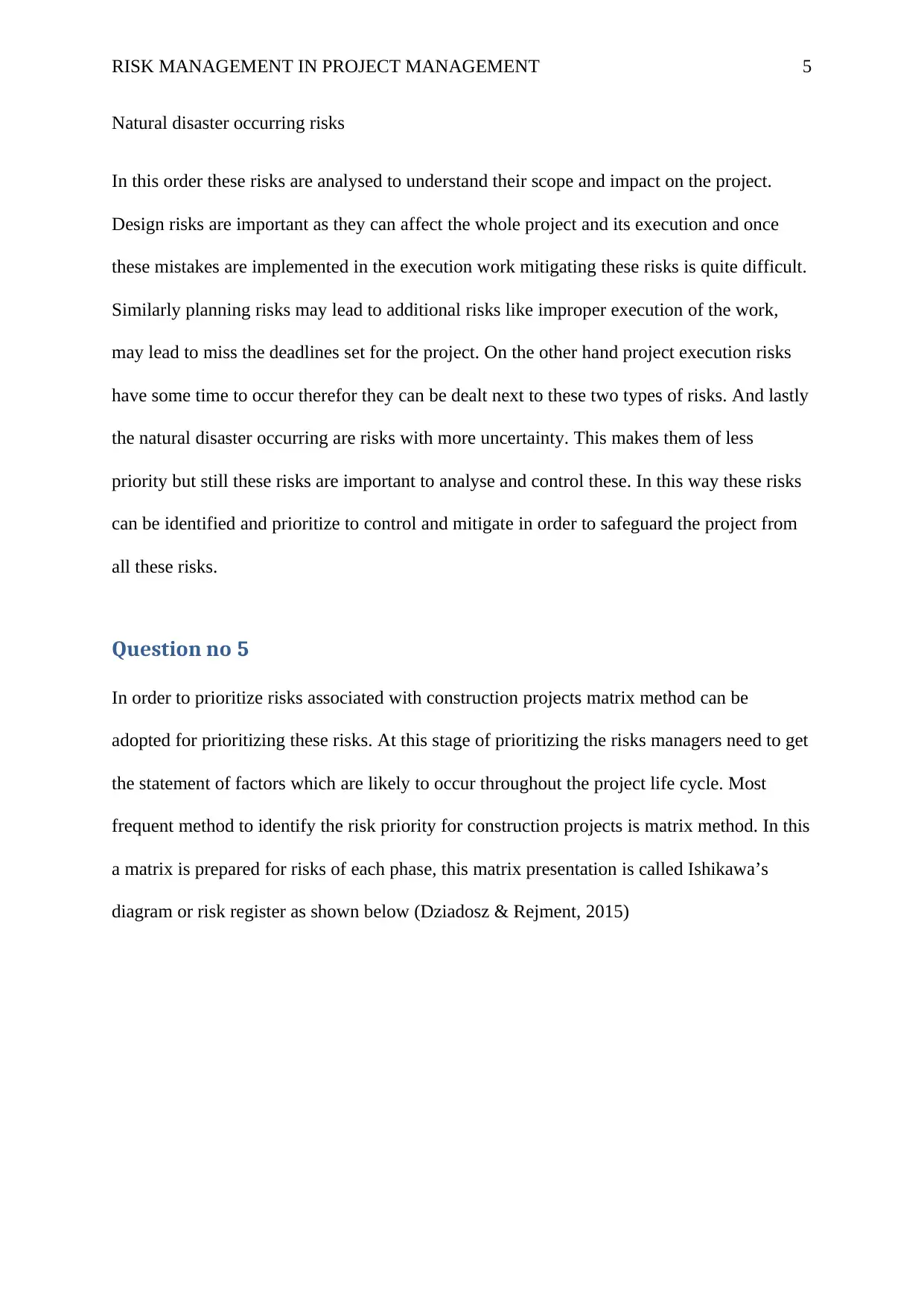
RISK MANAGEMENT IN PROJECT MANAGEMENT 5
Natural disaster occurring risks
In this order these risks are analysed to understand their scope and impact on the project.
Design risks are important as they can affect the whole project and its execution and once
these mistakes are implemented in the execution work mitigating these risks is quite difficult.
Similarly planning risks may lead to additional risks like improper execution of the work,
may lead to miss the deadlines set for the project. On the other hand project execution risks
have some time to occur therefor they can be dealt next to these two types of risks. And lastly
the natural disaster occurring are risks with more uncertainty. This makes them of less
priority but still these risks are important to analyse and control these. In this way these risks
can be identified and prioritize to control and mitigate in order to safeguard the project from
all these risks.
Question no 5
In order to prioritize risks associated with construction projects matrix method can be
adopted for prioritizing these risks. At this stage of prioritizing the risks managers need to get
the statement of factors which are likely to occur throughout the project life cycle. Most
frequent method to identify the risk priority for construction projects is matrix method. In this
a matrix is prepared for risks of each phase, this matrix presentation is called Ishikawa’s
diagram or risk register as shown below (Dziadosz & Rejment, 2015)
Natural disaster occurring risks
In this order these risks are analysed to understand their scope and impact on the project.
Design risks are important as they can affect the whole project and its execution and once
these mistakes are implemented in the execution work mitigating these risks is quite difficult.
Similarly planning risks may lead to additional risks like improper execution of the work,
may lead to miss the deadlines set for the project. On the other hand project execution risks
have some time to occur therefor they can be dealt next to these two types of risks. And lastly
the natural disaster occurring are risks with more uncertainty. This makes them of less
priority but still these risks are important to analyse and control these. In this way these risks
can be identified and prioritize to control and mitigate in order to safeguard the project from
all these risks.
Question no 5
In order to prioritize risks associated with construction projects matrix method can be
adopted for prioritizing these risks. At this stage of prioritizing the risks managers need to get
the statement of factors which are likely to occur throughout the project life cycle. Most
frequent method to identify the risk priority for construction projects is matrix method. In this
a matrix is prepared for risks of each phase, this matrix presentation is called Ishikawa’s
diagram or risk register as shown below (Dziadosz & Rejment, 2015)
⊘ This is a preview!⊘
Do you want full access?
Subscribe today to unlock all pages.

Trusted by 1+ million students worldwide
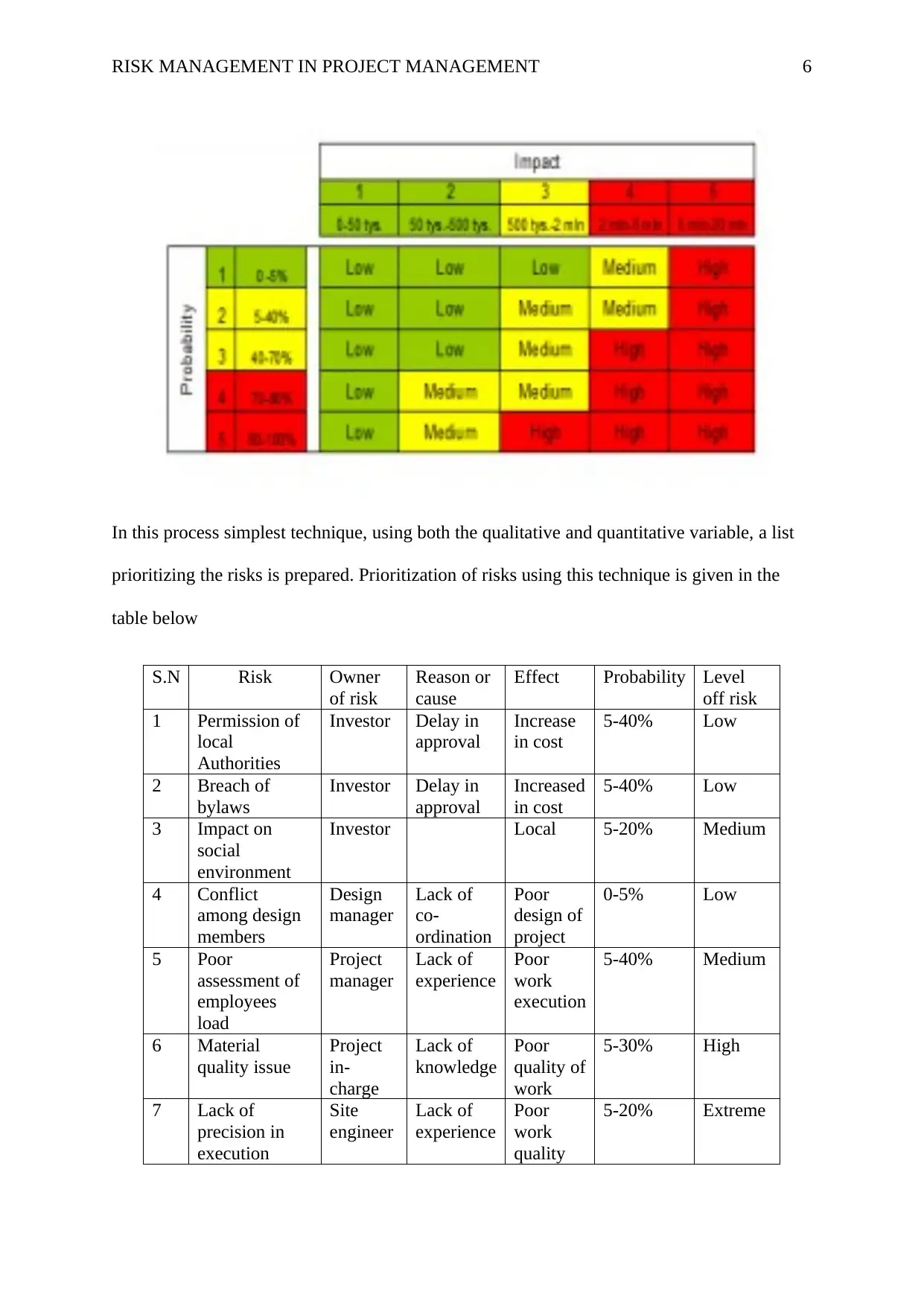
RISK MANAGEMENT IN PROJECT MANAGEMENT 6
In this process simplest technique, using both the qualitative and quantitative variable, a list
prioritizing the risks is prepared. Prioritization of risks using this technique is given in the
table below
S.N Risk Owner
of risk
Reason or
cause
Effect Probability Level
off risk
1 Permission of
local
Authorities
Investor Delay in
approval
Increase
in cost
5-40% Low
2 Breach of
bylaws
Investor Delay in
approval
Increased
in cost
5-40% Low
3 Impact on
social
environment
Investor Local 5-20% Medium
4 Conflict
among design
members
Design
manager
Lack of
co-
ordination
Poor
design of
project
0-5% Low
5 Poor
assessment of
employees
load
Project
manager
Lack of
experience
Poor
work
execution
5-40% Medium
6 Material
quality issue
Project
in-
charge
Lack of
knowledge
Poor
quality of
work
5-30% High
7 Lack of
precision in
execution
Site
engineer
Lack of
experience
Poor
work
quality
5-20% Extreme
In this process simplest technique, using both the qualitative and quantitative variable, a list
prioritizing the risks is prepared. Prioritization of risks using this technique is given in the
table below
S.N Risk Owner
of risk
Reason or
cause
Effect Probability Level
off risk
1 Permission of
local
Authorities
Investor Delay in
approval
Increase
in cost
5-40% Low
2 Breach of
bylaws
Investor Delay in
approval
Increased
in cost
5-40% Low
3 Impact on
social
environment
Investor Local 5-20% Medium
4 Conflict
among design
members
Design
manager
Lack of
co-
ordination
Poor
design of
project
0-5% Low
5 Poor
assessment of
employees
load
Project
manager
Lack of
experience
Poor
work
execution
5-40% Medium
6 Material
quality issue
Project
in-
charge
Lack of
knowledge
Poor
quality of
work
5-30% High
7 Lack of
precision in
execution
Site
engineer
Lack of
experience
Poor
work
quality
5-20% Extreme
Paraphrase This Document
Need a fresh take? Get an instant paraphrase of this document with our AI Paraphraser
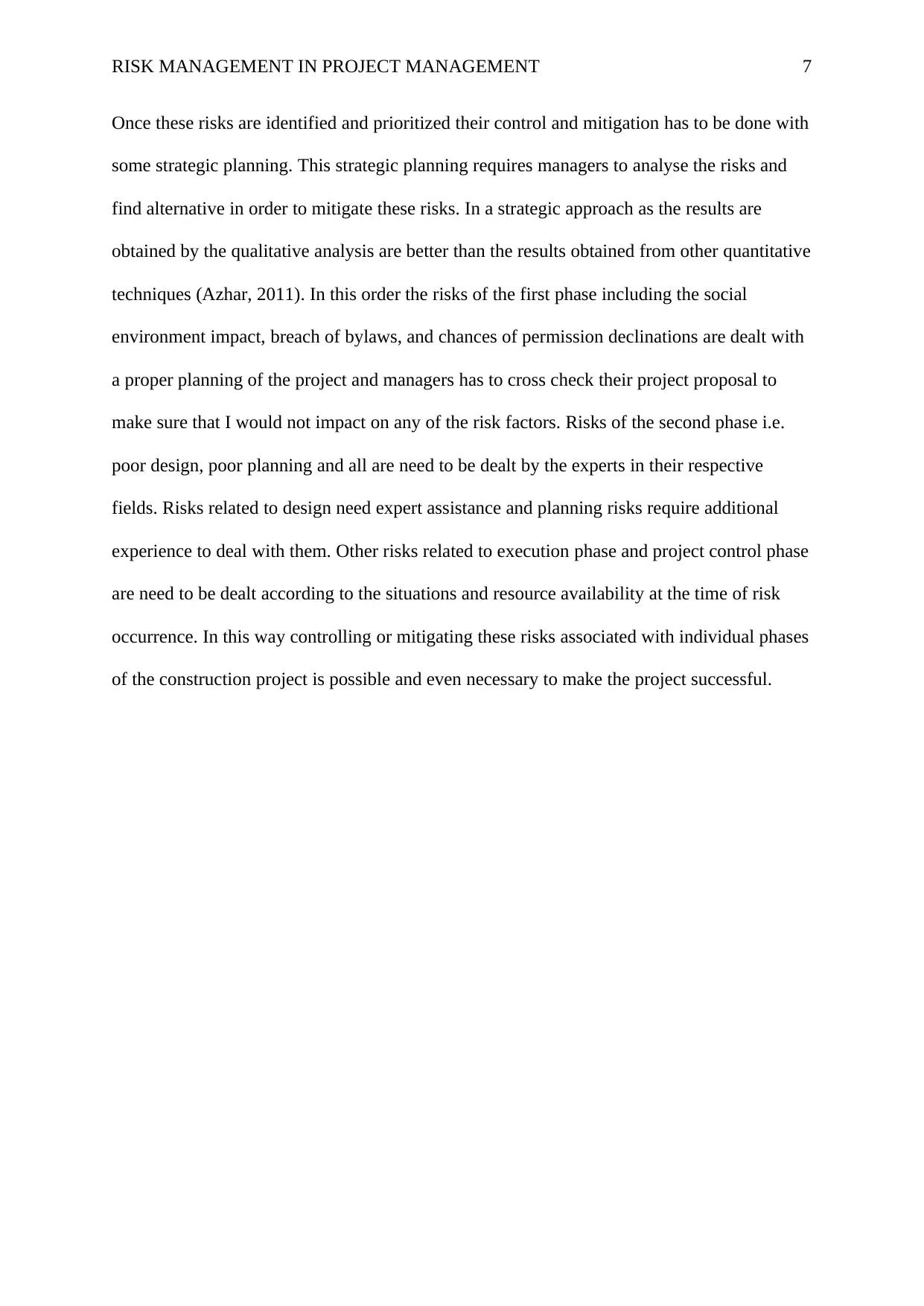
RISK MANAGEMENT IN PROJECT MANAGEMENT 7
Once these risks are identified and prioritized their control and mitigation has to be done with
some strategic planning. This strategic planning requires managers to analyse the risks and
find alternative in order to mitigate these risks. In a strategic approach as the results are
obtained by the qualitative analysis are better than the results obtained from other quantitative
techniques (Azhar, 2011). In this order the risks of the first phase including the social
environment impact, breach of bylaws, and chances of permission declinations are dealt with
a proper planning of the project and managers has to cross check their project proposal to
make sure that I would not impact on any of the risk factors. Risks of the second phase i.e.
poor design, poor planning and all are need to be dealt by the experts in their respective
fields. Risks related to design need expert assistance and planning risks require additional
experience to deal with them. Other risks related to execution phase and project control phase
are need to be dealt according to the situations and resource availability at the time of risk
occurrence. In this way controlling or mitigating these risks associated with individual phases
of the construction project is possible and even necessary to make the project successful.
Once these risks are identified and prioritized their control and mitigation has to be done with
some strategic planning. This strategic planning requires managers to analyse the risks and
find alternative in order to mitigate these risks. In a strategic approach as the results are
obtained by the qualitative analysis are better than the results obtained from other quantitative
techniques (Azhar, 2011). In this order the risks of the first phase including the social
environment impact, breach of bylaws, and chances of permission declinations are dealt with
a proper planning of the project and managers has to cross check their project proposal to
make sure that I would not impact on any of the risk factors. Risks of the second phase i.e.
poor design, poor planning and all are need to be dealt by the experts in their respective
fields. Risks related to design need expert assistance and planning risks require additional
experience to deal with them. Other risks related to execution phase and project control phase
are need to be dealt according to the situations and resource availability at the time of risk
occurrence. In this way controlling or mitigating these risks associated with individual phases
of the construction project is possible and even necessary to make the project successful.
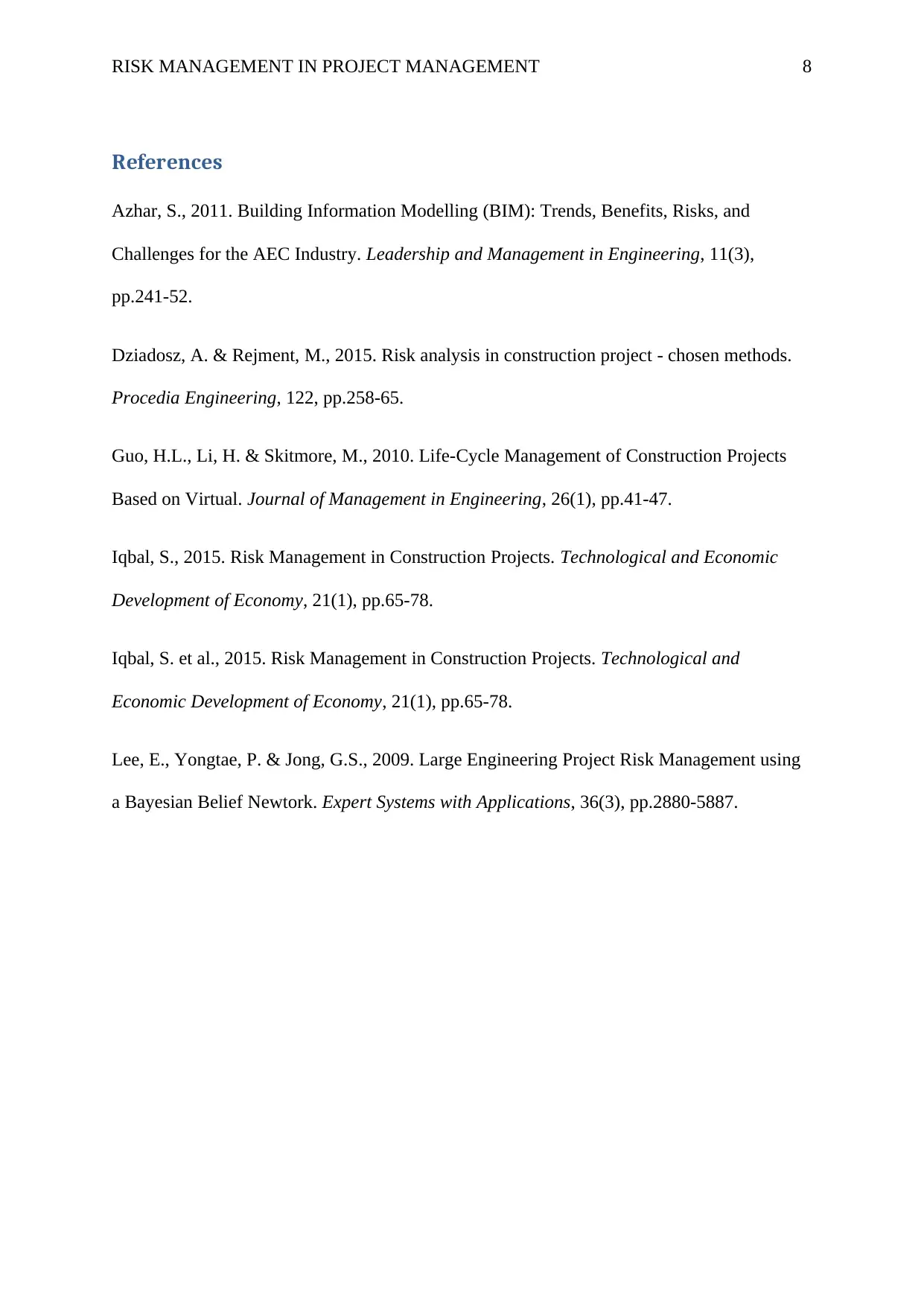
RISK MANAGEMENT IN PROJECT MANAGEMENT 8
References
Azhar, S., 2011. Building Information Modelling (BIM): Trends, Benefits, Risks, and
Challenges for the AEC Industry. Leadership and Management in Engineering, 11(3),
pp.241-52.
Dziadosz, A. & Rejment, M., 2015. Risk analysis in construction project - chosen methods.
Procedia Engineering, 122, pp.258-65.
Guo, H.L., Li, H. & Skitmore, M., 2010. Life-Cycle Management of Construction Projects
Based on Virtual. Journal of Management in Engineering, 26(1), pp.41-47.
Iqbal, S., 2015. Risk Management in Construction Projects. Technological and Economic
Development of Economy, 21(1), pp.65-78.
Iqbal, S. et al., 2015. Risk Management in Construction Projects. Technological and
Economic Development of Economy, 21(1), pp.65-78.
Lee, E., Yongtae, P. & Jong, G.S., 2009. Large Engineering Project Risk Management using
a Bayesian Belief Newtork. Expert Systems with Applications, 36(3), pp.2880-5887.
References
Azhar, S., 2011. Building Information Modelling (BIM): Trends, Benefits, Risks, and
Challenges for the AEC Industry. Leadership and Management in Engineering, 11(3),
pp.241-52.
Dziadosz, A. & Rejment, M., 2015. Risk analysis in construction project - chosen methods.
Procedia Engineering, 122, pp.258-65.
Guo, H.L., Li, H. & Skitmore, M., 2010. Life-Cycle Management of Construction Projects
Based on Virtual. Journal of Management in Engineering, 26(1), pp.41-47.
Iqbal, S., 2015. Risk Management in Construction Projects. Technological and Economic
Development of Economy, 21(1), pp.65-78.
Iqbal, S. et al., 2015. Risk Management in Construction Projects. Technological and
Economic Development of Economy, 21(1), pp.65-78.
Lee, E., Yongtae, P. & Jong, G.S., 2009. Large Engineering Project Risk Management using
a Bayesian Belief Newtork. Expert Systems with Applications, 36(3), pp.2880-5887.
⊘ This is a preview!⊘
Do you want full access?
Subscribe today to unlock all pages.

Trusted by 1+ million students worldwide
1 out of 9
Related Documents
Your All-in-One AI-Powered Toolkit for Academic Success.
+13062052269
info@desklib.com
Available 24*7 on WhatsApp / Email
![[object Object]](/_next/static/media/star-bottom.7253800d.svg)
Unlock your academic potential
Copyright © 2020–2025 A2Z Services. All Rights Reserved. Developed and managed by ZUCOL.





